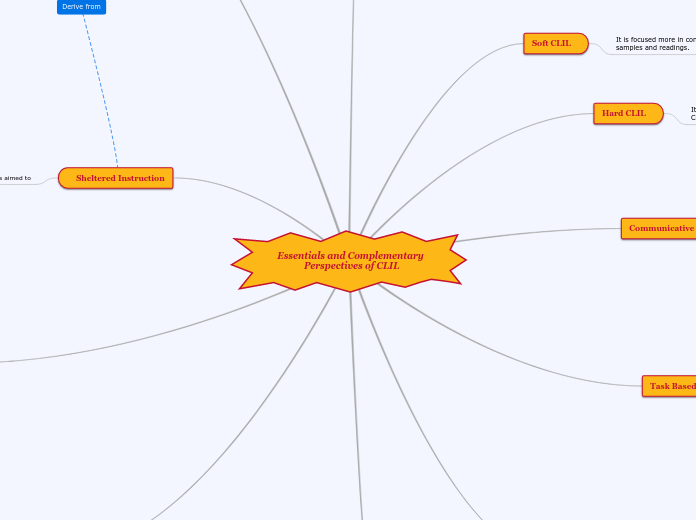Essentials and Complementary Perspectives of CLIL
CLIL Teachers
They work as team
They are
Not all language teachers
Planners and evaluators
Language usage promoters -conscious of cognitive process.
Supported by the country system
Soft CLIL
It is focused more in content. Use of grammar samples and readings.
Hard CLIL
It is the total immersion of CLIL: Language and Content are taught at the same time.
Communicative Language Teaching (CLT)
Teaching languages for communication. (Harmer,2012)
Develop the Communicative Competence. Promotes abilities or skills to maintain a speech in a community (Hymes, 1972).
It is the Nature of language learning and teaching. (Brown, 2007)
Teaching process which promotes
Real life expressions.
Autonomy and strategies.
Active pariticpation in students. And teachers as guides.
Use of language with purposes of meaning.
Fluency and accuracy.
Task Based Language Teaching (TBLT)
Focused on
Asking students for task completitions
Authentic language (meaning)
Assessment in outcomes (real world tasks)
Developing students confidence
Communication problems
Project Based Learning (PBL)
It takes periods from a week up to a semester
Students
Look for solving an specific problem or challenge
Work generally in groups
Are prepared for a Project
Are assessed individually
Focused on
Content
Improving different skills for social interaction (communication, management, self-assessment, etc.)
The quality of the result
Depth research
SIOP Model
Based on
Preparation
Considers
Content objectives
Adaptation of the content
Meaningful activities with English language and lesson concepts integrated.
Building background
Focused on
Students' experiences
Past learning vs. new concepts
Key vocabulary
Comprehensible Input
Helps with clear explanations
Use different methods
Strategies
Where students
Work step by step
Learn to use strategies
Make use of types of questions
Interaction
Provides discussion
Group work helps with objectives
Clarify concepts in L1
Practice/Application
Provides
Material
Activities related to content and language
All kind of skills
Review/Assessment
Considers
Key concepts
Key vocabulary
A feedback of the work
Comprehension and learning of students
Lesson delivery
Promotes
Content and language objectives
Students' engagement at 90%-100%
Adaptation of lesson according to the students' level
Sheltered Instruction
It is aimed to
Students with basic English in classrooms with
English learners
Native speakers and English learners
Integration of meaningful language and content
Promote sociocultural awareness
Develop the language competence
Cognitive Academic Language Approach (CALLA)
Created to
Improve skills in a foreign language and content concepts through the medium of the language.
Help students with a weak English speaking and writing Chamot and O’Malley (1987, 1994)
Consisting of 3 modules
Learning strategies
Development of academic language
Related to the curriculum
Its aims are
To improve autonomy
Culture knowledge
To choose strategies
To develop team work
Self-assessment
Content Based Instruction (CBI)
Study of
Language
Content material
According to Curriculum
Based in subject matter
Use of authentic language
Aimed at needs of groups of students
English for Specific Purposes (ESP)
Use of English in different types of Business
Like
Scientific
Tourism
Legal English
Nursing
